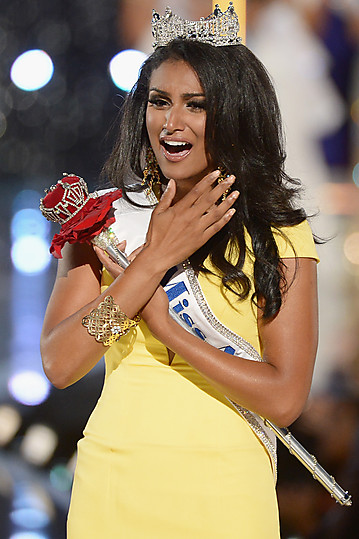Posts Tagged ‘Speak Out’
Skin Deep: Are beauty pageants still relevant?By Editor - September 21st, 2013 |
 |
|
Written By: Shalini Gopal In today’s day and age, are beauty pageants still relevant? Nina Davuluri won the Miss. America title last weekend, making her the first person of South-Asian descent to win the title. There has been a huge backlash from Americans who have been appalled that she won (but that is best left for another story). What I sat wondering was, why in today’s age, do we still have beauty pageants? I mean, in my opinion, beauty pageants continue to contribute in the objectification of women. Why do we need to judge a women’s beauty, and have them compete for a title based mainly on physical appearance? Toddlers and Tiaras, a popular show where toddlers participate in such ridiculous pageants further teach girls that appearance is what determines their success. We should teach our girls much more than that. Beauty without brains is nothing. In a bold move, France has just announced last week that it is banning all child beauty pageants because they are resulting in the hyper-sexualization of minors. (The Senate has adopted the Bill, and now will be making its way as a law). Organisers of such pageants may face a jail term of up to two years and a fine of 30,000 euros (£25,000; $40,000). Whenever I see a beauty pageant contest, I really feel disgusted. Do you see a group of men parading themselves around competing in beauty pageants to the same scale? Why do we women allow society to objectify us to mere objects measured on outward appearance? Have we not come a long way in fighting against oppression to further subject ourselves to this? I want to one day, be able to see a community of girls, who will not fret over how they look and measure themselves in outward worldly looks. I want them to measure their success by their intelligence, confidence and their contribution to society. In today’s day and age, I say, beauty pageants are for the weak. |
Shadism: Wear your shade with prideBy Editor - September 21st, 2013 |
 |
|
If you were asked to define the South Asian culture, what would you say? Would you say black and white? Out culture is not defined by one or two colors. The beauty of our culture lies in the the many rich and vibrant colors that it embraces. And like our culture, the people of our culture don’t come in one or two shades. They comes in so many different shades of beautiful. Embrace your shade. Wear your shade with pride. |
‘Good Morning – A Musical Journey’ by SE BoyzBy Editor - September 21st, 2013 |
 |
|
Written By: SE Boyz Montreal’s SE Boyz have released their debut album entitled ‘Good Morning – A Musical Journey’ to the general public this week. In case you haven’t heard of them, here’s a short bio of who they are: Established 2007, SE Boyz have become one the most influential independent Tamil diaspora artists we have seen grow here in Canada. They are a team of artists. Each member provides a unique style and when put together, form one of the most multi-talented teams to catch the public eye. Specializing in rapping, singing and music production, they have learned to incorporate these talents into diverse genres of music. However, what needs to be said is that they infuse the Tamil language in every song to preserve their cultural heritage. They have many hit singles such as Konjam Vekkam & Valiba Vayasu and have collaborated with numerous other Tamil diaspora artists and producers across the globe. They are currently working alongside TJ Production to deliver music to their audience. This new Good Morning project has been a 6 year dream for the team and is available now for purchase at online stores. You can purchse it on iTunes and Amazon. |
Thoondal 6: The Beauty of ‘Art’By Editor - September 21st, 2013 |
 |
|
Doodling away into the wee hours of the night, it took me a good while to realize that the topic for this week’s Thoondal was right in front of me. Art! Now, I speak of visual arts in particular, but of course the term ‘Art’ is inclusive of so many different types of creative expression, all of which need no words to communicate. This brings me to the purpose of this piece. Music, dance and visual arts, what is it about these beautiful expressions that is able to capture our hearts and carry along the artist’s intention or message to his or her audience without using language? It is amazing how art has travelled across countries, breaking ethnic and language barriers all over the world. Even news of violence against people does not always reach a third person in its entirety. We relate to such news, but not to the extent that we must in order to feel the complete pain of the victim. How is it then that we are able to look a painting and feel the mood that the painter wanted us to feel? The colours, the strokes, the light and the shadows? Music reaches our hearts with its varied notes or sounds: the highs, the lows, the loud, the quiet, and perhaps most importantly, silence. The dancer mesmerizes us with his/her grace, quick feet, gestures, loud thumps and flashes of emotions. The pictures that are etched in the viewers’ minds as such are almost always in resemblance of the artists’ own imaginations, and it is this that is truly the beauty of ‘Art’. The ability to draw in a vast audience with no need for explanation makes ‘Art’ one of the best and strongest tool for activism, change and developing a better future. As such, the beauty of ‘Art’ is also its greatest power, and we must embrace it. Use your creativity to its highest potential and realize its utmost value. About the Author: Shayanika Suresh is a Law Graduate currently working on establishing her legal career. She is also a passionate writer and has self-published a collection of short stories, “Lips no longer sealed”. Shayanika’s passion to raise awareness of various social issues that affect individuals and society as a whole is evident in her work, leaving a message for the reader to take home. |
Thangachi’s Corner: In RemembranceBy Admin - September 10th, 2013 |
 |
|
CTYA’s Blog has started a new Feature every other Wednesday called “Thangachi’s Corner”. “Thangachi’s Corner” is a comfortable space to discuss relatable topics and issues relevant to the Canadian Tamil youth of today. For more information about this feature or to suggest a topic, feel free to e-mail us at blogs@ctya.org! Written By: Keerthana Raveendran I was in fifth grade French class when the first plane hit. At the time, precisely twelve years ago, I was entirely oblivious to what was happening at our southern neighbour. I remember sitting in groups of five, chatting away after the morning announcements as our teacher gathered her things, fascinatedly looking at the limited edition Harry Potter collectibles she’d strewn across our desks at a time when the series was gaining corporate popularity. The details of the lesson escape me to this day, but I remember vividly when the principal’s voice echoed through the PA system minutes later, interrupting us. Her voice was grave. She had an important announcement, was going to give us a minute to quieten down and prepare ourselves before speaking again. I remember as we waited with bated breath during that one minute, and then, when the broadcast hit, the stunned silence within my classroom. I remember feeling remorse at the statistics she’d guesstimated, but still, at the tender age of nine, I could not quite comprehend the extent of the damage that had been done. It wasn’t until years later than I came across the footage that had been played all over the country while I’d been in school. I was researching the incident for a school project and found myself encountering the many perspectives of the story that had unfolded that day. Older now, I came to understand the magnitude of the tragedy. The number of people who had been trapped in the upper floors of the towers, unable to escape; who felt terror upon feeling the ground beneath them shudder upon impact; for whom realization must have slowly seeped in that it was impossible to descend and escape the building with flames and plane wreckage as their obstacle below—many of them had made the heart wrenching decision to throw themselves over the edge of the building rather than to await a suffering demise at the hands of the destruction. Those innocents who sat in the planes—they expected no more than a pleasant flight, believing that their only obstacles would be the popping in their ears with altitude and perhaps a mild case of airsickness. They must have been aware of their situation well in advance, powerless to change their circumstances, left only to haphazardly swipe their credit cards through the slot of the airplane phones across from their seats, call their loved ones, and say goodbye. Those many firefighters, who risked their lives to climb the attacked buildings in an attempt to salvage lives, only to find themselves engulfed in flames. The horror of those outside the buildings, who witnessed not only one, but two planes hit. And the people at home, the husbands, wives and children who picked up the telephone, called and called and called, hoping to reach their families. I remember being nine years old and witnessing our school flag at half-mast in a gesture of respect and mourning to commemorate those who had suffered during the events of 9/11. It is now twelve years later. Our flags no longer rest at half-mast in remembrance. Families who had once lost loved ones have begun to heal. The towers that once collapsed are now being rebuilt. Tragedy is as constant in our lives as change, but with all tragedies—9/11, the World Wars; and even those in our own Tamil heritage, Black July, the Sencholai massacre—time serves to heal. Before September the eleventh became the day the United States was attacked, it signified birthdays, proposals and anniversaries around the world. For some, it was the day a coveted job was earned. For others, it was the day of reunion with loved ones after a long journey. Misfortune can reach our doorstep any day, but we are capable of changing how we view it. And so, while I might still think back from time to time on those who suffered that morning I played with Harry Potter cards in French class, I’m still quite certain that September the eleventh will hold many miracles around the world for years to come. About the Author: Keerthana Raveendran, known by her flock as Thangachi, is an aspiring author with an eye for the eccentricities of the Tamil Canadian culture. As an unemployed student with a mountain load of student debt, she is currently broke, so you will probably be able to relate to her. As a writer, she has a special kind of wit that is present on the page and absent during the awkward conversations you tend have with her in person. Thangachi is currently a Masters student studying English at York University. |
Thoondal: Do we really care about what others think?By Admin - September 5th, 2013 |
 |
|
Written By: Shayanika Suresh I often catch myself saying “I don’t care what people think, I’m going to do what I feel like doing!” But lately, I’ve been thinking. When we say that, do we actually mean that? In a world dominated by divisions, of race, class, sex and gender, do we not care what people think when we measure ourselves by these standards that have been prescribed for us by the society that we live in? When we dress in brand-named clothing and carry ourselves with grace and flair, are we not thinking about what people will think of us? When we practice etiquette at the dining table, are we not trying to maintain a certain image? Consciously and unconsciously, we are constantly trying to fit into a particular mold. We are always trying to impress others, and we yearn for compliments on a daily basis. Be it a friend, partner or spouse, we seek to be flattered, to be praised. Then, how can we say that we don’t care what others think? If we are to agree that we do care what others think, another question swiftly arises. Are our words and actions then moulded by what others think? Do we always make decisions in order to please people? In my opinion, that cannot be the case. Yes, we do reflect on what others might say or think with regards to our words, actions and decisions, but we do not make our choice solely based on this reflection. There are many occasions, I find, when we act in contrary to what other people think, solely because we feel like doing something else. But is individual choice guaranteed to win every time? Or are we in denial of how much of an impact a third person’s perception of us can have on us, as individuals? CTYA’s Blog has started a new feature every Thursday called ‘Thoondal’, meaning inspiration, stimulation, or inducement. Through these weekly features, the author hopes to inspire you, stimulate your senses and induce you to think deeply about the topics she addresses and finally, to use those thoughts to inspire many more wonderful youth like you. About the Author: Shayanika Suresh is a Law Graduate currently working on establishing her legal career. She is also a passionate writer and has self-published a collection of short stories, “Lips no longer sealed”. Shayanika’s passion to raise awareness of various social issues that affect individuals and society as a whole is evident in her work, leaving a message for the reader to take home. |
Thoondal: Let your fears go, and fight with faith!By Admin - August 29th, 2013 |
 |
|
Written By: Shayanika Suresh Take writing for example. I know I love to write, and I always have. But, am I good at it? That question has crossed my mind too many useless times, and I am certainly not proud of it. This book, however, has made me realize that I am not the only victim of such thinking. Perhaps that was the purpose of the gift, and I am ever so grateful for it. For many years, I shied away from socializing, hiding my huge plastic glasses behind a book, no matter where I went. I barely spoke a word in class, and muttered in response when I was spoken to. With my closest of friends, I would speak with enthusiasm, laugh out loudly but all that quickly disappeared in the midst of a stranger. For those who know me now, I have clearly come a long way from the shy me, but my fears shift onto other subjects each and every day, and as such, every day is a fight for my faith. That which has captured my passion, I am able to conquer with ease, and that which I fear, I am imprisoned by. It is this fear, I have realized, that is my biggest enemy, and I am sure there are many more like me. To those like me, I write this piece. The first step to victory is overcoming your fears. The first step to overcoming your fears is to admit them. Open up to yourself. You need not tell the world, but don’t fail to tell yourself. Once you admit the fear is there, you will be able to take the next step to fight it. Every day is a gift that has been granted to us. Yes, we often take it for granted, and we do not realize its value. But it really is a gift to live, and we are blessed to be able to live our dreams. So why should we let our fears stop us from living those dreams? Fear of losing, fear of dying. Who cares? Let the future be what it chooses to be. Live the present with all your heart, and work towards achieving your dreams. However far you go, that itself is an accomplishment worth celebrating. Every day, I am pushed and driven by beautiful people in my life, to reach further and higher. To those people I am blessed to have in my life, this is my little thank you. About the Author: Shayanika Suresh is a Law Graduate currently working on establishing her legal career. She is also a passionate writer and has self-published a collection of short stories, “Lips no longer sealed”. Shayanika’s passion to raise awareness of various social issues that affect individuals and society as a whole is evident in her work, leaving a message for the reader to take home. |
Thangachi’s Corner: The Art of Tamil CuisineBy Admin - August 28th, 2013 |
 |
|
CTYA’s Blog has started a new Feature every other Wednesday called “Thangachi’s Corner”. “Thangachi’s Corner” is a comfortable space to discuss relatable topics and issues relevant to the Canadian Tamil youth of today. For more information about this feature or to suggest a topic, feel free to e-mail us at blogs@ctya.org! Written By: Keerthana Raveendran The task of learning Tamil cuisine was my Everest once upon a time. I spent a lot of time helping my mother cook as a child, was preparing breakfast for my family every morning by the time I was in grade seven, and could follow a recipe to the letter to make anything I wanted, but when it came to Tamil food, I was stumped. You see, I always need a plan. I need to know exactly what has to be done before I do it. I need to be able to coordinate multiple tasks to ensure maximum efficiency. In fact, while cooking, I even make a point of looking through the Nutrition Facts labels to simultaneously optimize health benefits. This particular nature made it all the more difficult for me when I realized that Tamil cuisine was very much about the senses. While I, who have taken a myriad of chemistry courses in the past, am rather procedural in the precise manner that I use lists and follow recipes, Tamil cuisine focuses instead on the experience. There is no set measurement regarding the amount of salt that is put into this curry or that. You don’t measure the amount of onions you slice, count out a specific number of curry leaves to wash, or quantify individual mustard or fennel seeds in teaspoons before tossing them into the pot. Instead, it is your intuition that is put to work as you ballpark these values in a trial and error fashion. This makes for a very subjective process that puts quite a bit of responsibility onto the chef, as what is too salty for one may be tasteless for another. I suddenly understood why a lot of the Tamil adults with whom I came into contact often complained about high blood pressure. Read more |
Senthamil Things: A Man’s Best FriendBy Admin - August 20th, 2013 |
 |
|
By: Senthamil Stefi In 1870 in a courtroom in Missouri, United States, George Graham Vest represented a farmer who was suing his neighbour for shooting his dog. Representing this client, Vest closed the trial with his statement, “The one absolutely unselfish friend that a man can have in this selfish world, the one that never deserts him and the one that never proves ungrateful or treacherous is his dog.” This phrase was than shortened to a dog being “a man’s best friend,” and that is how this phrase emerged into society. Indisputably, dogs have been labeled as “a man’s best friend” time and time again due to their nature of loyalty and amazing sense of companionship. Though not “all” dogs are friendly by nature, their sense of loyalty remains consistent which seems to heavily lack in our human world. Now, how did they become “a man’s best friend”? Before the 18th century, dogs were generally not kept as household pets but rather were used to aid in hunting, guarding, or work. The ones that were kept at home were very small and were labeled as “lap dogs”. They were not regarded highly by society. Beginning in the mid-1700s, the notion of dogs as nurtured and favourable household pets began to appear. Dog hospitals, dog food and many other dog essentials emerged during the 19th century. Now during recent times, it is clearly evident in our society of the western world that dogs are valued just as much as children, as terms such as “dognapper” and “dognapping” have been adapted. I guess it can be said that a dog was “always” a man’s best friend…it just took humans a long time to realize that and appreciate it. In summary, human beings are selfish in nature… whereas dogs are some of the most self-less beings in the world that will be there for you no matter what…thus, making out to be the best depiction of what a TRUE best friend is. |
Thoondal: Dear Smartphone Users…By Admin - August 15th, 2013 |
 |
|
CTYA’s Blog has started a new feature every Thursday called ‘Thoondal’, meaning inspiration, stimulation, or inducement. Through these weekly features, the author hopes to inspire you, stimulate your senses and induce you to think deeply about the topics she addresses and finally, to use those thoughts to inspire many more wonderful youth like you. Written By: Shayanika Suresh Thoondal: Dear Smartphone Users… Have you been neglecting your desktop computer or laptop lately? Or have you abandoned it completely? Are you now browsing the internet, checking your social networks, and playing games, all on your smartphone? Yes? Then, I believe we are on the same page. The way technology has evaded our universe and the rate at which it has done so is simply incredible. The existence of our modern society is now entirely or at least for the most part, dependent on technology. In the morning, we wake up to the alarm set on our phones. Some of us use electric toothbrushes, trimmers, hair dryers, and straighteners. We boil water in electric kettles and warm our food in microwaves. We vacuum our rooms, we mow our lawns, and we plug in the snowblowers to clean our driveways in the winter. That’s sociological advancement, no doubt, but as a result, are we failing to maintain interpersonal relationships with others ‘in person’? Or at least, spending less time doing that than messaging friends on facebook, and emailing our professors? I believe this personal connection is essential to our society, as it allows us to judge character, to distinguish honesty from treachery, and to express our emotions to an extent that no emoticon could ever completely fulfil. The question then is, how do we balance these two exciting worlds? What do we do to ensure that we remain personally connected to the people in our networks despite our super cool gadgets? About the Author: Shayanika Suresh is a Law Graduate currently working on establishing her legal career. She is also a passionate writer and has self-published a collection of short stories, “Lips no longer sealed”. Shayanika’s passion to raise awareness of various social issues that affect individuals and society as a whole is evident in her work, leaving a message for the reader to take home. |

